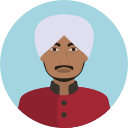Contents
Environmental Factors Shaped the Development of Societies in Africa
Main idea
Africa’s north/south alignment and lack of domesticable animals prevented the development of transcontinental political powers and limited the development of trade networks.
During this historical period, African state and cultural systems were some of the most varied and diverse in the world. They ranged from expansive trading empires to stateless tribal societies. This diversity resulted from environmental factors that made contact and communication between African peoples difficult. Like in the Americas, climatic features created natural barriers between communities.
Two important environmental features that shaped Africa included the following.
Geographic alignment
Africa's north/south alignment meant that more climatic variations separated African civilizations, making it harder to move across the landmass separating regions. East/west land alignments, such as Eurasia, allows for fewer climatic variation or the ability to maneuver around. Central Africa is also tropical, with dense forests that limit movement and communication.
Lack of domesticatable animals
The lack of native pack animals on the African continent limited communication and trade because there were no animals that societies could use transport goods or move people. While Arab traders' introduction of the camel to North Africa made movement and trade within the Sahara desert easier, the camel did not work in other climatic zones within Africa.
The environmental conditions in Africa and their effects on social and state formation are most similar to the Americas.
Impacts of environmental factors on African state formation
While there are exceptions and variations, the following were common features of African state systems. Notice how the environmental factors above resulted in smaller governments and less economic exchange.
Smaller state systems
States were smaller and more fragmented than in other regions of Eurasia (exceptions: the trading empires of Mali and Songhai).
Lack of transcontinental power
Africa had many regional powers spread across the continent. However, it lacked a large transcontinental power like the Abbasid, Song dynasty China, or the Mongol Empire.
Smaller State Systems
Islamic rulers became the dominant African powers primarily through wealth generated through trade.
Traditional cultures remained important:
Traditional African culture dominated tribal regions and areas well connected to global trading systems. In areas that converted to Islam, conversion was primarily limited to elites. Only until the 19th century did Islam become the dominant religion of most people in the African regions where Islam had expanded.
Large African Trading Empires
Main idea
West Africa developed large Islamic empires that gained wealth and power by controlling trade along the Trans-Saharan trade network.
West Africa contained a series of large trading empires that gained wealth through access to trade along the Trans-Saharan trade network.
Mali
The Mali Empire emerged in 1235 and built its wealth on control of the West African gold fields and taxation of the gold and salt trade.
Mali spanned over a thousand miles from the Atlantic coast into the interior of West Africa.
- Mali had a centralized bureaucratic government.
- Mali’s kings broke Mali into provinces that governors ran.
- After the death of Mali’s first leader Sundiata in 1255, influenced by their contacts with Islamic merchants, Mali’s leaders converted to the Islamic faith.
- The greatest of Mali’s leaders, Mansa Musa, possessed an army of over 100,000 men.
- Mansa Musa went on a hajj (holy Islamic pilgrimage) to Mecca between 1324 and 1325. He brought and distributed so much gold along his journey that stories about his wealth and power spread throughout Wet Asia and Southern Europe. Scholars refer to Mansa Musa as the wealthiest man in history.
After Mansa Musa died, the quality of Mali’s leaders declined. In addition, by the early 1400s, decreasing tax revenue left Mali with less money to finance its military to secure its borders.
Source: Ibn Batutta was a Muslim scholar who traveled all around the Islamic world, writing about his travels. Below he describes an audience (gathering) at the court of Mali Sultan Mansa Sulayman.
[The sultan] has a lofty pavilion … where he sits most of the time… There came forth from the gate of the palace about 300 slaves, some carrying in their hands bows and others having in their hands short lances and shields… Then two saddled and bridled horses are brought, with two rams which, they say, are effective against the evil eye… The interpreter stands at the gate of the council-place wearing fine garments of silk… and on his head a turban with fringes which they have a novel way of winding… The troops, governors, young men, slaves, … and others sit outside the council-place in a broad street where there are trees… Anyone who wishes to address the sultan addresses the interpreter and the interpreter addresses a man standing [near the sultan] and that man standing addresses the sultan.
Songhai
As Mali declined, the Songhai people gained power along Mali’s eastern borders. They captured the trade routes under Mali’s control and used the tax revenue to expand their military.
Songhai’s Islamic rulers built an impressive state.
- Songhai had a centralized and bureaucratic government with agriculture, defense, and treasury ministries.
- The emperor had absolute power over the government.
- Leadership was dynastic, with power passing from fathers to sons.
- The emperor appointed governors to manage urban areas.
The peak of Songhai power lasted less than 100 years. Songhai’s power declined as their weapons technology fell behind their neighbors’ more advanced weaponry. Their Moroccan neighbors to the northwest had built a modern army equipped with gunpowder and cannons. The Songhai had only spears and swords. The end of the Songhai came in 1591 following Morocco’s invasion and capture of key trading routes and cities.
Smaller State-Based Kingdoms
Main idea
Smaller kingdoms also developed that benefited from global trade connections.
Regional kingdoms were smaller monarchies that had significant influence and control within their regions. However, they did not develop expansive empires like Mali or Songhai. Regional state-based powers were present in all areas of Africa.
Great Zimbabwe
Great Zimbabwe was a powerful South African kingdom between the 12th and 15th centuries. Great Zimbabwe’s built its success on its connections to the Swahili trading cities on the East African coast.
- Great Zimbabwe had vast reserves of gold that they exported through Swahili (see below).
- Merchants traded great Zimbabwe’s products in Persia, India, and China.
- The center of Great Zimbabwe was near the modern city of Masvingo in Central Zimbabwe.
- In Great Zimbabwe, a person’s wealth was measured by how many cattle and wives they owned.
Kings ruled Great Zimbabwe. The wealth of these kings came from taxing gold and other goods that traveled through their lands to Swahili coastal trading cities.
- The king of Great Zimbabwe was usually the wealthiest citizen.
- Kingship was often hereditary and passed from one generation to the next.
- There was an upper class of nobility that supported the king. This nobility obtained their wealth through the cattle that they owned.
- The kings in Great Zimbabwe had no army. To maintain power and authority, rulers had to maintain close relations with their people and accommodate different people and groups’ views.
- Zimbabwe rulers claimed a divine connection to their traditional monotheistic god Mwari.
Great Zimbabwe’s power declined rapidly around 1450. While scholars have not established definitive causes for the decline, many believe that environmental changes led to land no longer supporting the population.
Ethiopia
The area around modern Ethiopia remained Christian and independent following the expansion of Islam into North Africa. During the 14th century, Ethiopia partnered with Rome and the Catholic church to fight against the growth of Islam in Ethiopia and the holy lands. Ethiopia’s rulers gained wealth through the taxation of trade that moved through the area. Agriculture, gold mining, and ivory were Ethiopia’s most significant exports.
The Ethiopian government was feudal.
- Wealthy regional landlords with personal armies would pledge allegiance to the king and provide soldiers to the king.
- These feudal lords held immense power over the lands they controlled and the people who lived on those lands.
City-States
Main idea
City-states developed that shared similar cultures with their neighbors but maintained independent leadership. Like other African state systems, these city-states gained wealth through trade connections.
Several significant societies in Africa were city-states. City-states are independent governments that are no bigger than large cities. African city-states during this historical era often shared a common language and culture but lived under different leaders and governments.
The Hausa city-states
The Hausa are an ethnic group that shares a common language and culture in West Africa. Modern Hausa people live in the countries of Nigeria and Niger to the east of the Mali and Songhai empires’ old borders. The Hausa people are modern Africa’s largest ethnic minority group.
Unlike their western neighbors of Mali and Songhai, the Hausa people did not develop a large, centralized state. Instead, starting around 1000 CE, the Hausa developed a tradition of city-state governance.
- Different Hausa leaders controlled individually governed walled cities and the agricultural areas in the surrounding countryside.
- Hausa governments did have bureaucracies.
- Hausa kings governed with the help of ministers. These ministers ran various bureaucratic functions of the government.
- Hausa rulers often attempted to invade their neighbors and incorporate neighboring city-states within their territory. Conquered city-states usually quickly regained their freedom and independence.
- Hausa governments acquired wealth by taxing trade goods that moved through their cities.
- City-states traded specialized goods, such as animal hides, cloth, dyes, feathers, precious metals, and salt. The city-state of Zazzau was a significant source of enslaved people captured from societies south of the Hausa city-states.
The Swahili city-states
Indian Ocean trading connections transformed Africa’s east coast from an agriculture and fishing economy to a vital hub on global trading networks. Over time, many of these small villages along the Indian Ocean coast developed into powerful trading city-states. Islam transformed Swahili civilization and became the city-states’ dominant belief system as Islamic traders interacted and settled within the region.
Like the Hausa in West Africa, the different Swahili city-states shared a common culture but were politically independent of each other.
- Each ruler controlled their city and the rural areas directly around their borders.
- Rulers of the city-states grew wealthy by taxing trade that flowed through their cities allocated on the western edge of the Indian Ocean trade network.
- Traders rode the monsoon winds in the winter bringing goods from Asia before riding the monsoon winds back to Asia in the summer with raw materials and African manufactured goods. The goods destined for Asia often came from the interior regions of Africa from places like Great Zimbabwe.
The Swahili city-states retained their independence until the 15th century, when the Portuguese arrived and took over coastal trade in East Africa.
Stateless Societies
Main idea
Africa also had many tribal socities that were stateless and did not use formal state structures like a monarchy.
Africa also contained stateless societies that lacked a formal, organized government.
The Efe
One of the largest stateless groups was the Efe ethnic group in Central Africa. The ancestors of the Efe had inhabited their lands for tens of thousands of thousands of years.
- The Efe were semi-nomadic and lived in groups of between 10 and 100 related members.
- Each group consisted of different branches of the family.
- Women were responsible for gathering food, and men were responsible for hunting.
- Respected male elders held leadership roles. However, this elder did not function as a chief or final decision-maker.
- The group made decisions through consensus. If one family within the tribe disagreed, they could make their own choices or leave the group. The Efe did not have a formalized and recorded legal system.
The Igbo
The Igbo lived in modern Southern Nigeria southeast of the old Mali and Songhai trading empires.
- Power in Igbo society was a complex interaction between lineage (family) groups.
- If a dispute arose, the oldest members of family groups would gather to negotiate a resolution to the conflict. If children were in dispute, parents would decide; grandparents might decide if parents were in dispute.
- The key to maintaining order was to balance power between the families so that no one family would become too powerful and dominate the whole group.
Stateless societies existed in many areas during this period in history. Many tribal governments in North America did not have formal governments. The Mongols, who in the 13th century created the largest land empire in history (see unit 2), were stateless when they started conquering and building their empire.
Ibn Batutta was a Muslim scholar who traveled all around the Islamic world writing about his travels. Below he describes an audience (gathering) at the court of Mali Sultan Mansa Sulayman.
[The sultan] has a lofty pavilion … where he sits most of the time… There came forth from the gate of the palace about 300 slaves, some carrying in their hands bows and others having in their hands short lances and shields… Then two saddled and bridled horses are brought, with two rams which, they say, are effective against the evil eye… The interpreter stands at the gate of the council-place wearing fine garments of silk… and on his head a turban with fringes which they have a novel way of winding… The troops, governors, young men, slaves, … and others sit outside the council-place in a broad street where there are trees… Anyone who wishes to address the sultan addresses the interpreter and the interpreter addresses a man standing [near the sultan] and that man standing addresses the sultan.





































